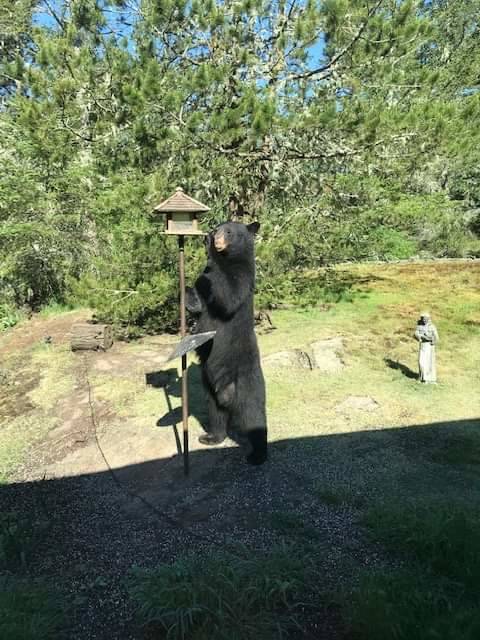As the second anniversary of the 2017 black bear visit neared, another Ursus Americanus has returned to Orcas Island.
Sheriff Ron Krebs confirmed with the Journal that there is a bear on Orcas once again. It was spotted in the Olga area on May 10 on the very same property where the previous bear was humanely trapped.
“I honestly don’t know if this is the same bear. I do know that they get bigger over time, and change color from cinnamon to black,” Janice Williams, the property owner, said. “The fact that we experienced the first sighting of this guy on Orcas today makes me think that, if it is a different bear, it is quite uncanny that he showed up here first.”
Undersheriff Zac Reimer said the bear is likely the same one that was recently seen on Camano and Whidbey islands in the past few weeks. Krebs said they are calling in the Washington Department of Fish and Wildlife to capture and relocate the animal.
“Over the next few days they will be looking at different options to deal with the bear,” Reimer said in a press release. “At this point, the bear has not shown signs of aggressive behavior towards humans but does like getting into bird feeders.”
If you see the bear, call the sheriff’s office immediately at 360-378-4151 or WDFW at 425-775-1311.
Previous incident
Over Memorial Day Weekend in 2017, a juvenile male black bear showed up on Orcas after visiting Blain, Ferndale and The Lummi Reservation west of Bellingham. WDFW Officers had set traps in many of those locations that proved to be unsuccessful.
“I have never had a bear swim to an island,” WDFW Game Warden Dave Jones told the Journal in 2017.
At the time, there were several different reported descriptions of the bear, leading some to believe there was more than one.
“It is very common to get wide ranges of descriptions when it comes to bears,” Jones said in 2017. “The very same bear will be called into me where one person says it 100 pounds and black in color and then the next caller says it is 300 hundred pounds and brown in color.”
The bear was captured on June 8, 2017, on the property of the same Orcas resident who was first to see the bear this year and whose yard the bear was humanely trapped. It reportedly smelled like donuts. He was taken to Marblemount and released.
The American Black Bear (Ursus americanus) can swim incredible distances. One of the largest populations of the species lives a short distance away on Vancouver Island. The animals live an average of 20 years in the wild, can weigh between 200-600 pounds and are as tall as 5-feet, 6-inches. While their diet consists mainly of vegetation, berries and bugs, they will eat fish and mammals and can develop a taste for human food and trash. According to the Smithsonian’s story “How to Avoid Being Eaten by a Black Bear,” one study estimated that there were 750,000-900,000 black bears distributed across North America, and their numbers have been growing.
Back in 2017, Ruth Milner of WDFW advised residents to lock up their garbage, keep all pet food inside and remove bird feeders.
“This time of year, bears are after calories and you’d be amazed at how many bird feeders attract bears,” she told the Journal in 2017. “Bears are omnivores and seeds provide high-calorie fats so they are easy targets for bears. We have a difficult time convincing people that birds don’t need food from us at this time of year and the best thing to do is take them down to dissuade bears.”
WDFW asks that people not attempt to feed or harm the bear. Shooting it is considered poaching. If you see a black bear standing up on its hind legs, it is just being inquisitive. State wildlife offices receive hundreds of black bear complaints each year regarding urban sightings, property damage, attacks on livestock, and bear/human confrontations. Black bears have been known to attack and kill humans. According to the department’s website, 95 percent of calls about black bears are the result of irresponsibility on the part of people who allow access to trash, pet food, bird feeders, and do not properly store food while camping.
According to “Backpacker” magazine, “In the 2000s, there have been 27 fatal incidences so far in North America, resulting in 29 deaths. 15 were in Canada, three were in Alaska, two were in Tennessee, and single fatal attacks happened in New York, New Mexico, California, Pennsylvania, Colorado, Utah and Montana. Seventeen of those attacks were perpetrated by black bears, and 10 by grizzlies.”
For more information about black bears, visit https://wdfw.wa.gov/species-habitats/species/ursus-americanus.



